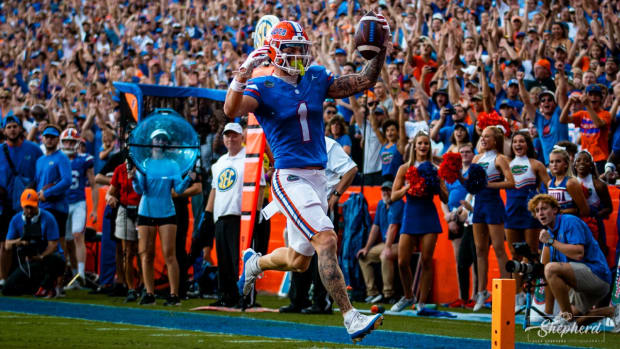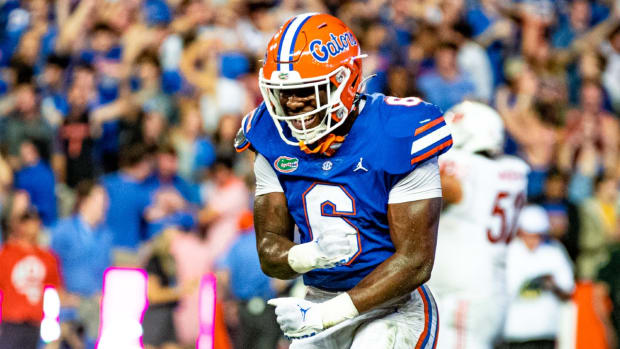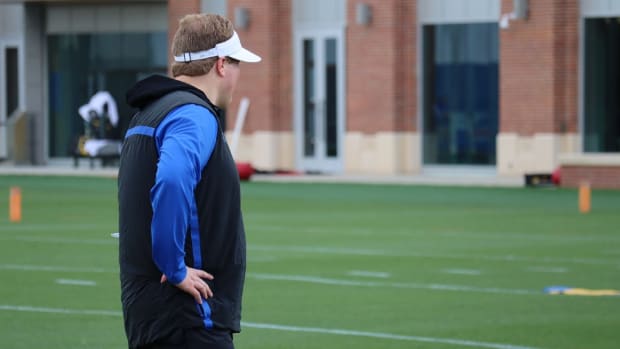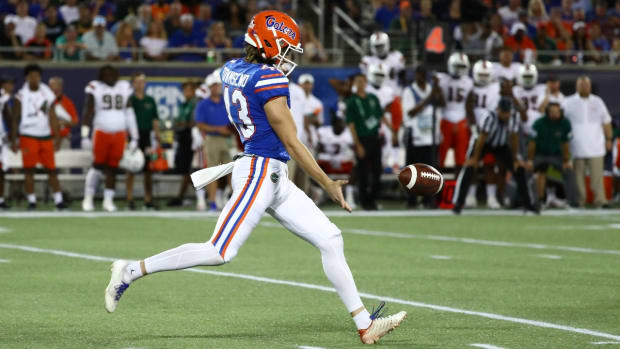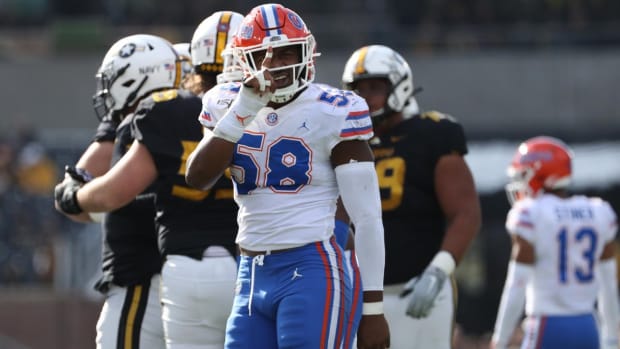Five Most Important Florida Gators 2020 Rising Juniors
As we continue to take a look at the top talent of Florida's roster by class, today we will move onto the next group of veterans following the seniors with the team's five most important juniors returning in 2020.
While there were several options to choose from on both sides of the ball, these five players will continue serving or take on instrumental roles with the team. Entering their junior years, several players will be NFL Draft-eligible for the first time in their careers, and a big season in 2020 could elevate their stock.
Defensive coordinator Todd Grantham returns three key, top-to-bottom defensive pieces in the junior class, as Florida looks to maintain a top defense in the SEC after finishing with the No. 2 squad last year. On the offensive side of the ball, two true juniors will find the ball in their hands' plenty - expectations will be high.
Here are the five juniors we believe are vital for Florida to build upon its successful 2019 campaign. The list is in no specific order.
Defensive end Zachary Carter (R-Jr.)
After filling in nicely for Jabari Zuniga throughout the 2019 season at strong-side defensive end, Carter should take on the role as a full-time starter this year.
In 13 games, starting two, Carter finished with the third most quarterback pressures on Florida's SEC-leading pass rush, with 20 according to Pro Football Focus. On the box score, Carter finished second in sacks with 4.5, tied for sixth in tackles for loss with six, while recording 30 tackles, a forced fumble, and two batted passes. He played less than half of the team's defensive snaps - taking the field on 403 out of 833 possible plays.
With Zuniga and star pass rusher Jonathan Greenard both off to the NFL, Carter has big shoes to fill as an impact player in UF's pass rush. He's bulked up with healthy weight this offseason, up to 287 lbs. with a body fat percentage of 16% as he shared on Twitter. That weight adjustment, paired with his quick get-off at 6-foot-4, should help him improve his run defense strength as well.
Linebacker/STAR Amari Burney (Jr.)
Nicked up by injuries throughout the 2019 season, Burney has all of the tools to be a playmaker for Florida when he's settled into one position. He split his snaps between weak-side linebacker and STAR nickel cornerback, playing well in both spots but owning a skill-set that translates well to the latter position.
The 6-2, 224 lb. former safety moved into the box late in his freshman season and made an immediate impact, including his first career sack against Michigan in the 2018 Peach Bowl. In eight appearances last season, seeing 144 snaps at linebacker and 133 at nickel cornerback, Burney tallied 37 tackles, two quarterback pressures, an interception, a pass breakup, and a fumble recovery.
He had a couple of spotty moments allowing catches for short gains, but Burney is typically an instinctual coverage player in space and that showed up when he played nickel more than linebacker. According to PFF, Burney allowed an 81.3% completion percentage, giving up 125 yards and recording an interception on 16 targets in coverage in the five games when he primarily played linebacker. In three games primarily playing STAR, Burney only allowed receptions on 53.8% of his 13 targets, giving up 89 yards and a touchdown, recording a pass breakup.
While those targets aren't broken down to where Burney lined up on the specific play, the sample size is about even given his snap and target count. He appears to hold coverage down better in games that he's featured at STAR, and as the position was inconsistent last year, Burney could slide there full-time in 2020 and make a big impact - so long as he remains healthy.
Cornerback Marco Wilson (R-Jr.)
After contemplating for some time, Wilson elected to return to Florida rather than put his name in the NFL Draft hat this year. He had immediate moment towards a professional future when he first stepped on the field at Florida, starting the opening game of his freshman year and tallying a team-leading 10 pass breakups.
However, a torn ACL derailed Wilson's sophomore campaign, and while he played across 13 games 2019, it naturally took some time for him to get acclimated. He eventually made a transition to STAR and filled in well amidst struggles from Trey Dean III, and finished his season with three interceptions, two pass breakups, 36 tackles, and 2.5 tackles for loss.
PFF credits Wilson with giving up a reception on 68.6% of his 51 targets, which he will want to improve on in 2020 although that mark isn't anything terrible. Running mate C.J. Henderson allowed 54.1% of his 37 targets to be caught, and ended up being selected ninth overall in the 2020 NFL Draft.
That isn't to compare Wilson to Henderson, they are different players with different skill-sets. But as Wilson enters 2020 two years removed from his injury, that completion percentage should go down as he completely returns to form as a veteran leader in the secondary.
Running back Dameon Pierce (Jr.)
Now-New York Jets running back Lamical Perine made quite the transition as Florida's bell-cow running back last season. After splitting carries nearly 50-50 with Jordan Scarlett in 2018, when Florida averaged the SEC's fourth-most rushing yards per game with 213.5, Perine had to adapt to run-blocking struggles in 2019 that forced Florida to flip its offensive script.
Perine ended up finishing third on the pass-heavy team in receptions with 40, which is even more impressive when you consider eight players caught at least 20 passes. Though, quietly, Pierce finished ahead of Perine in yards per rushing attempt at 5.6 on 54 carries - Perine posted 5.1 yards per carry on 132 rushes, though he entered the 2019 Orange Bowl at 4.5.
Pierce's aggressive, down-hill rushing style made him an effective post-contact rusher, breaking tackles and fighting for extra yards. The 5-10, 207 lb. back broke 13 tackles in 2019, averaging 4.43 of his rushing yards per carry after first contact with a defender according to Pro Football Focus, equating to 79% of his production coming after contact. Pierce finished six games with more yards after contact than actual rushing yards, while Perine had two, for reference.
Florida needs to see improvement across the offensive line in order to make the run game function at full strength, but a natural increase in Pierce's usage should lead to positive results.
Tight end Kyle Pitts (Jr.)
Pitts looks to be the centerpiece of Florida's offense in 2020 should the Gators continue to lean on the pass. Quarterback Kyle Trask found comfort after stepping in last season by building immediate chemistry with Pitts, and the 6-6, 239 lb., agile tight end finished the season leading the team with 54 receptions.
Entering his true junior season with first-round NFL Draft chatter surrounding his name, Pitts has drawn perhaps the highest praise a future tight end prospect could by PFF's Mike Renner.
Offering dynamic receiving ability given his size and athleticism, Pitts caught 52 of his 74 targets from behind the line of scrimmage up to 20 yards downfield according to PFF, averaging 12 yards per reception. Tough to bring down due to his intangibles, 4.2 of his yards per reception came after the catch.
Pitts could take a step forward as a run blocker in his second season as a starter although he was decent at times, however the tight end was sound on limited pass-blocking snaps. PFF credits Pitts with two quarterback pressures allowed across 78 pass-blocking snaps.
Blocking will be important as Pitts looks towards professional aspirations, and would benefit Florida, but the passing game will depend on his continued dominance after losing five key pass-catchers to the NFL following the 2019 season.
